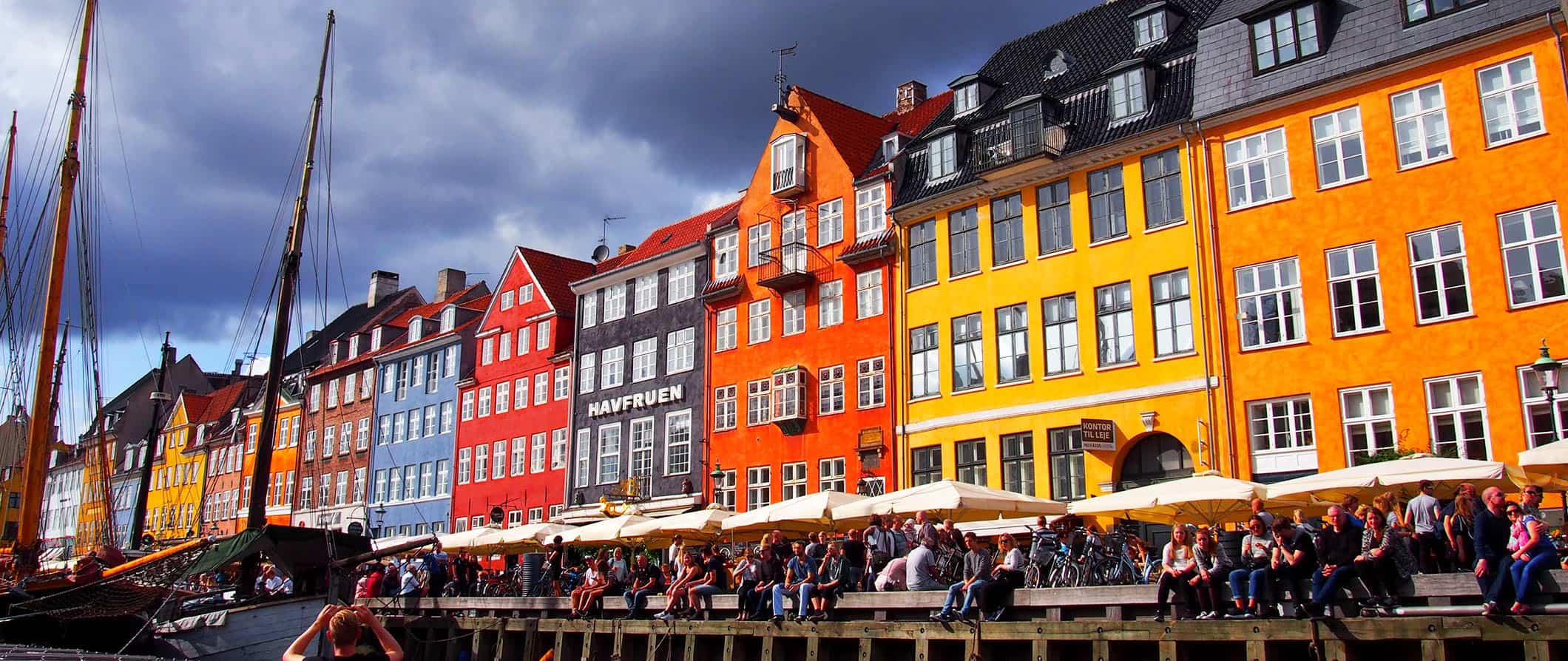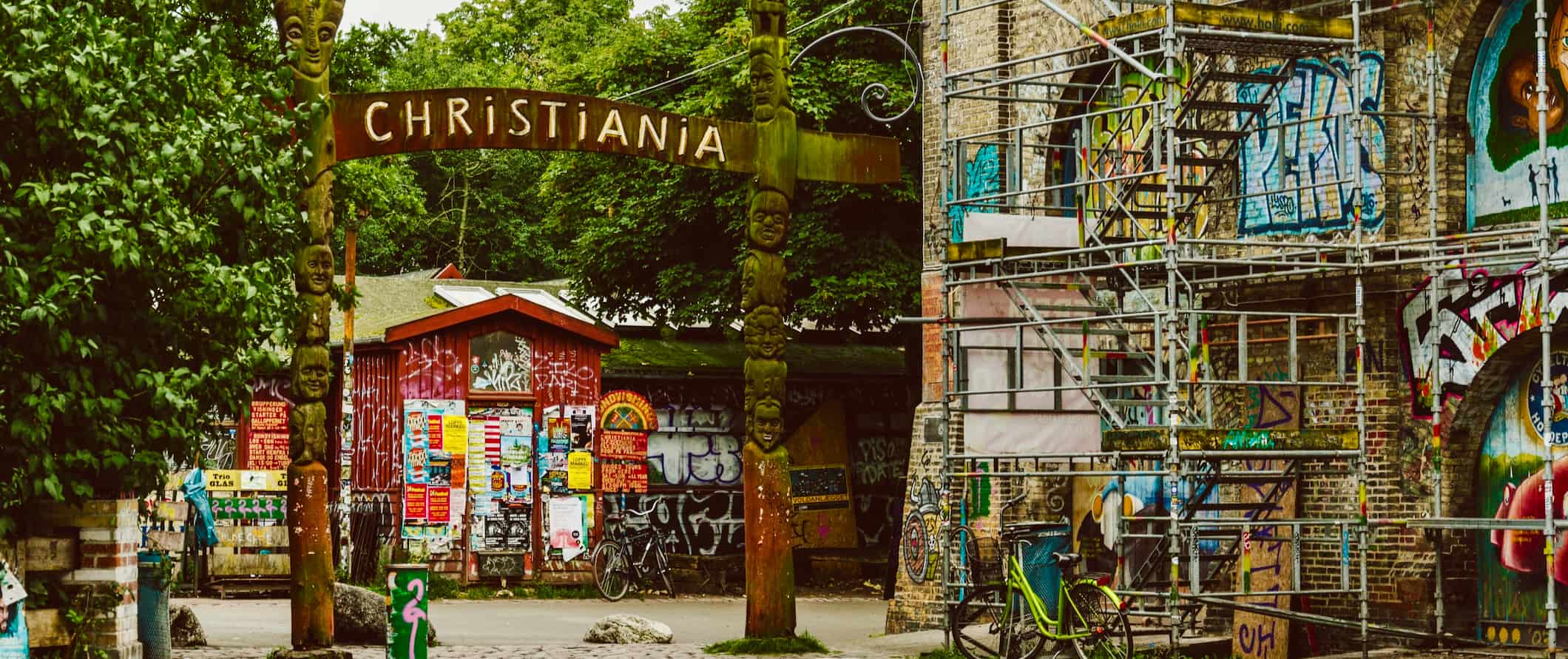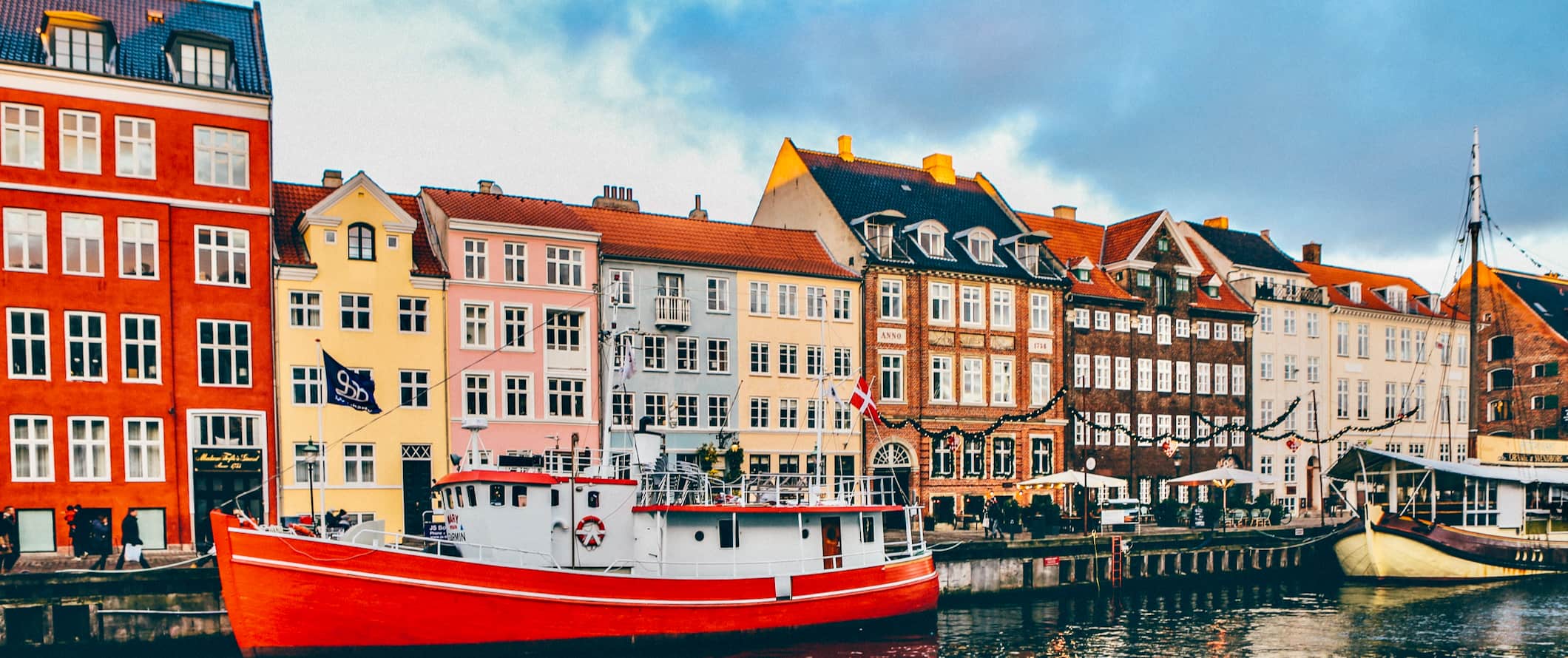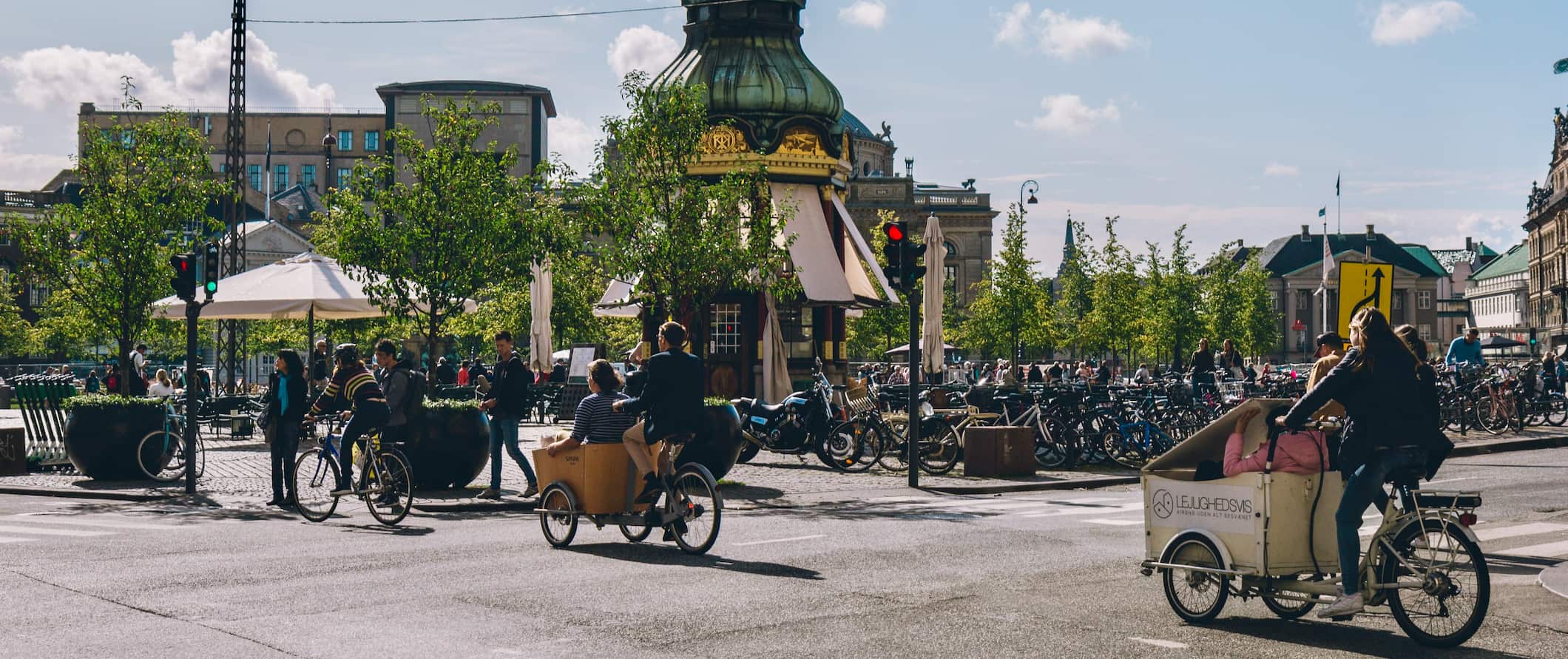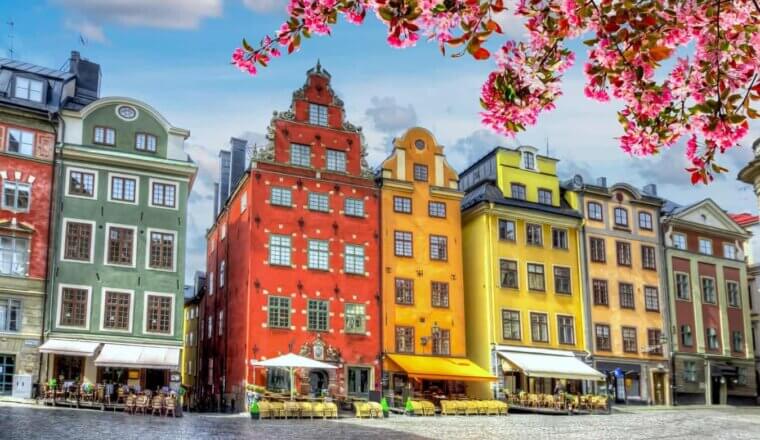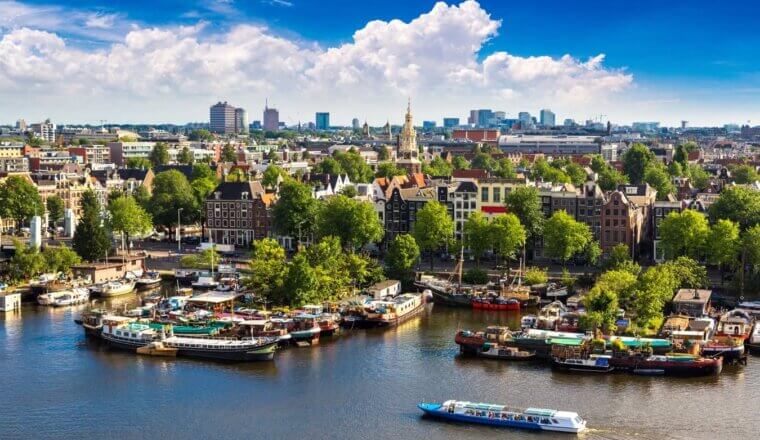As the capital of Denmark, Copenhagen (København in Danish) has a long and rich history. It was the center of the Danish empire for hundreds of years, and, as such, it is home to numerous palaces, historic buildings, and cultural relics.
But modern Copenhagen is not a city steeped in the past. The town’s classic architecture and canals are juxtaposed by great infrastructure, new buildings, and a high-tech transit system.
It’s one of my favorite cities in the world.
I’ve been here a dozen times and never get tired of my visits. The city is beautiful, clean, green, and the locals are always fun to hang out with. There is a spirit and vibe that screams “life is good here.” It’s infectious and will have you wondering why more places aren’t like this.
Denmark is constantly voted as one of the best and happiest countries in the world and, after visiting Copenhagen, it’s easy to see why. The quality of life here is incredible.
Use this travel guide to Copenhagen to help you plan your trip, save money, and make the most of your visit!
Table of Contents
Top 5 Things to See and Do in Copenhagen
1. Explore Freetown Christiania
This intentional community/would-be micronation has been around since the 1970s. Most people come to hang out and smoke the weed openly sold here (though in recent years, the locals have pushed out the drug dealers, decreasing drug sales by around 75%). There are also several small shops as well as two breweries here. The community is one of the biggest draws in the country and welcomes 500,000 visitors each year. Come for the cool beer gardens, people-watching, and colorful murals. Photography is discouraged by the locals though.
2. Cycle around the city
Renting a bike is the easiest way to explore the city — it’s how the locals travel. In fact, there are more bikes in the city than people (and five times as many bikes than cars!). Bikes can be rented all around the city, with prices per hour (25 DKK) or per day (around 120 DKK). For guided bike tours, expect to pay 350 DKK. Most tours last 2-3 hours and include all the main highlights.
3. Take a boat tour
The canals and harbor of Copenhagen are very beautiful (and super clean. You can actually see the bottom of the canals). Hour-long boat tours leave from Nyhavn and, while “touristy,” you will find a surprising number of locals on them drinking a beer on a sunny day. Tours range from 99-200 DKK per person.
4. Have fun at Tivoli
Opened in 1843, Tivoli is an amusement park in the center of the city. While it may not be the most popular place for everyday travelers, I had a blast here, especially playing bumper cars with my friends and drinking beer. Complete with a Ferris wheel, games, roller coasters, and a concert hall, this is an awesome place to spend an afternoon. Avoid the weekend and school holidays when the place is overflowing with families. Weekday admission is 145 DKK and weekends cost 155 DKK.
5. Hang out in Nørrebro
This is one of the city’s coolest areas. Trendy bars and shops sit right next to dive bars and cheap kebab shops, so spend some time strolling the streets and taking in the eclectic sights. Grab a cocktail at The Barking Dog, or check out the music venues/nightclub Rust.
Other Things to See and Do in Copenhagen
1. See the Christiansborg Palace Ruins
Christiansborg Palace is the home of Denmark’s parliament and the Prime Minister’s office. Located underneath the parliamentary palace are the ruins of Bishop Absalon’s fortress, which dates back to 1167. It’s dark and damp down there, giving it a very crypt-like and ancient feel. I was really impressed with the detailed information provided about the fortress and its evolution to its current palace form. Admission is 165 DKK, however, it’s free with the Copenhagen Card.
2. Visit Round Tower
Rundetaarn (The Round Tower) is a 17th-century tower that was built as an observatory. It’s actually the oldest functioning observatory in Europe. And through a long, tiring walk to the top, it provides a sweeping view of the old part of Copenhagen. The stairs are actually equestrian stairs, which means they are built in such a way that horses and mules can navigate them (probably to bring up equipment to the top). Admission is 40 DKK.
3. See the Church of Our Saviour
Located near Christiania, this church is worth seeing for its giant spiraling bell tower. The interior of the church is rather ordinary and features a few interesting paintings, but the winding tower is what makes it worthwhile. It has always been regarded as something of a test of manhood to climb up and touch the globe on the summit, nearly 350 feet up in the air. The view from the top is worth the effort. Admission is 65 DKK.
4. Visit the Hans Christian Andersen Experience
Hans Christian Andersen is the famous author of numerous classic children’s stories, including The Little Mermaid, The Princess and the Pea, The Ugly Duckling, and more. While this place is designed for children and features Disney-like displays and sets, I really enjoyed it. Inside, you learn about his life and can read all of Andersen’s tales, which were a lot shorter and darker than I had thought. It was quite an eye-opener — Disney lied to me all these years! Admission is 155 DKK for adults and 100 DKK for children.
5. See the National Museum
Established in 1807, this museum covers over 14,000 years of history in Denmark, from the Ice Age and the Vikings all the way to the present. There are all kinds of cool artifacts from the Viking era and lots of neat historical tidbits. Exhibitions cover prehistory, the Middle Ages and Renaissance, coins and metals, indigenous art, ancient Greece and Rome, and more. The museum has rotating temporary exhibitions as well. Admission is 110 DKK.
6. Explore the Danish National Gallery
The Danish National Gallery has an incredible collection of art from the likes of Rembrandt, Picasso, Matisse, and other masters. There are over 9,000 paintings in their collection and several hundred thousand other works. Established in 1896, there are also a number of paintings by Danish artists from the “Golden Age” (1800-1850). Some 40,000 items from the collection are available online in their virtual museum as well. Admission is 120 DKK and free for anyone under 18.
7. Experience the nightlife
Copenhagen has a variety of pubs, lounges, and clubs. This city doesn’t start pumping until about 1am and goes very late. I would try to spend at least one night out. For nightclubs, check out Culture Box, which has three different rooms playing separate genres of music to dance to. If dancing isn’t your thing and you’d much rather sip some delicious drinks, try K-Bar, Lidkoeb, and Gensyn Bar. Just be prepared to splurge as alcohol isn’t cheap here!
8. See the Little Mermaid
A homage to one of Hans Christian Andersen’s most beloved characters, this bronze statue may be small, but it’s worth taking the time to see. Expect there to be a crowd — it’s a popular attraction! Also, don’t miss the nearby Gefion Fountain. It features a sculpture of the Norse goddess Gefion (goddess of unmarried women) plowing the land with oxen (Norse mythology states that she created the land that is Denmark after plowing it with her oxen).
9. Relax in Kastellet Park
Kastellet fortress was built in 1664 to guard the city. It’s one of the best-preserved fortresses in Europe. The citadel was built in a pentagon and is still an active military installation. Inside there were numerous barracks as well as a windmill, church, and other outbuildings. Today, it’s a public park and cultural monument. The park has relaxing gardens, plenty of trees, and tranquil ponds surrounding it. It’s a popular spot for locals to walk and jog as you can also walk along the ramparts. It’s right near the Little Mermaid and is a wonderful place to relax on a warm day with a book and a picnic.
10. Shop at a flea market
In the summer months, there are numerous flea markets around the city that are perfect for browsing. Many are open just on the weekends and offer an assortment of odds and ends. Nørrebro Flea Market is Denmark’s longest and narrowest, stretching 333 meters (1,092 feet) near Assistens Cemetery on Nørrebrogade. Other markets worth checking out are Frederiksberg Loppemarked, Gentofte Loppemarked, and Ritas Blå Lopper.
11. Day trip to Malmö
For a day trip, consider visiting Malmö, Sweden’s third-largest city. It’s under an hour away and you can spend some time strolling around the historic city center. You’ll also get to cross the famous Øresund bridge, a landmark made famous by the hit Scandinavian crime drama The Bridge (Broen in Danish). Don’t miss the Stortorget market (which is over 500 years old) and Malmö Castle.
12. Explore Roskilde
Known as the ancient city of Denmark, Roskilde was Denmark’s capital from 960 to 1536. Located just 40 minutes from the city by car (30 minutes by train), this is an amazing city to view the country’s history, whether it be the 12th century Roskilde Domkirke cathedral; Sankt Laurentius, the 16th-century bell tower, or the Viking Ship Museum, which has five original Viking longships on display. It plays host to Europe’s largest music festival every June and the Roskilde Cathedral is the most famous in the country as well as a UNESCO World Heritage Site.
13. Relax at the botanical gardens
These gardens span over 24 acres right in the middle of the city. The greenhouses date back to the 1870s and are home to over 13,000 plants and flowers (some of which are over 200 years old). Don’t miss the Arctic “greenhouse” which uses air conditioning to simulate conditions in the arctic so its arctic plants can thrive. There’s also a butterfly house with hundreds of butterflies you can visit. Admission to the gardens is free, while some of the buildings cost 40-60 DKK to access (free with the Copenhagen Card).
14. Visit Rosenborg Castle
This Renaissance castle was built by Christian IV at the start of the 17th century. The palace was the official royal residence until 1710 and has all kinds of royal artifacts on display, such as the Danish crown, the crown jewels, three life-sized lion statues, and the coronation throne. The interior is incredibly lavish with all kinds of ornate designs, murals, tapestries, and art. It has a very over-the-top feel similar to places like Versailles in France. Admission is 125 DKK and free with the Copenhagen Card.
15. Take a canal tour
One of the best ways to take in the city is by boat. Cruise around the city’s canals and learn about Copenhagen’s past and the important role the canals played in its development. Most include stops at Copenhagen’s main sights, including The Copenhagen Opera House, Christiansborg Palace, and the Little Mermaid. Tours cost around 100 DKK and are free with the Copenhagen Card.
For more information on other destinations in Denmark, check out these city guides:
Copenhagen Travel Costs
Hostel prices – Dorms with 6-8 beds cost around 200 DKK per night. Free Wi-Fi is standard and most hostels have self-catering facilities if you want to cook your own food. Only a couple of hostels include free breakfast so be sure to book those hostels in advance if that’s a priority for you. Private rooms begin at 675 DKK per night.
There are several campgrounds outside of the city with prices starting at 85 DKK per night for a basic plot (a flat space for a tent, usually without electricity; there is an additional charge for these amenities).
Budget hotel prices – For a budget two-star hotel, prices start at 600 DKK per night for one person, with a twin bed and shared bathroom. For a room with a private bathroom, expect to pay at least 800 DKK. These usually include free Wi-Fi and basic amenities like a TV, AC, and a coffee/tea maker.
Airbnb is available but expensive when not booked early. Expect to pay an average of 500-800 DKK per night for a private room (though if you book early you can find them for 350 DKK), while entire homes/apartments cost around 800-1,000 DKK (they average double that price, however, so be sure to book early).
Food – Danish cuisine leans heavily on meat and seafood. Cod, herring, and beef are never far from any meal. Dark bread and open-faced sandwiches (smørrebrød) are a staple for both breakfast and lunch. Liverpaste is a local favorite, as is shrimp on bread. Most traditional dinner meals revolve around meat and potatoes.
A meal out at a restaurant serving traditional cuisine costs around 125 DKK. Cheap sandwich shops cost 90 DKK while a fast food combo (think McDonald’s) is around 85 DKK. For a three-course meal and a drink, expect to pay at least 350 DKK.
Chinese food and Thai food can be found for as little as 80 DKK while Italian cuisine ranges from 110-140 DKK. A large pizza costs around 75 DKK.
Beer is 50 DKK while a cappuccino/latte is around 42 DKK. Bottled water is 20 DKK.
If you are going to cook your own food, expect to pay around 400-500 DKK per week for basic staples like vegetables, pasta, rice, and some meat or fish.
Backpacking Denmark Suggested Budgets
On a backpacker budget of 500 DKK per day, you can stay in a hostel dorm or camp, cook all of your meals, use public transportation to get around, limit your drinking, and do mostly free activities like walking tours and enjoying the parks. If you want to drink more, add another 100-200 DKK per day.
On a mid-range budget of 1,275 DKK per day, you can stay in a private Airbnb, eat out for a few meals, enjoy a couple of drinks here and there, take the occasional taxi, and do some paid activities like visiting museums and castles and going on a canal tour.
On a “luxury” budget of 2,300 DKK or more, you can stay in a hotel, eat out for all your meals, drink more, do as many activities as you’d like, and take taxis (or rent a car) to get around. This is just the ground floor for luxury though. The sky is the limit!
Copenhagen Travel Guide: Money-Saving Tips
Copenhagen is an expensive city in an expensive country. You’ll spend a lot here if you aren’t careful. If you find cheap accommodation, stick to happy hours, and cook your meals, you’ll be able to cut your costs a lot without limiting too much of what you do in the city. Here are some quick tips to help you save money in Copenhagen:
- Get the Copenhagen Card – If you plan to do a lot of sightseeing and visit a lot of attractions then I highly recommend you get the Copenhagen Card. It offers discounts and free admission to museums and attractions and includes free transportation. Cards are offered for 24 hours (438 DKK), 48 hours (655 DKK), 72 hours ( 803 DKK), 96 hours (930 DKK), and 120 hours (1,050 DKK).
- Take a free walking tour – One of my favorite ways to start a trip is with a free walking tour. You get to see all the main sites while chatting with an expert local guide. Copenhagen Free Walking Tours offers a comprehensive free tour that serves as an excellent intro to the city. Just be sure to tip your guide!
- Refill your water bottle – The water in Denmark is safe to drink and is held to very high standards. Skip buying bottled water here and refill your bottle instead. LifeStraw makes a reusable bottle with a built-in filter so you can always be sure your water is clean and safe.
- Eat on the street – Street stalls sell hot dogs and sausages for cheap. To eat on a budget, stick to them.
- Get a Hostelling International card – Danhostel.dk is the national accredited Hostelling International network. They operate 60+ hotels throughout the country so you’ll want to get an HI card if you plan on staying at their hostels during your stay. If purchased in Denmark, HI cards are 160 DKK.
- Stay with a local – Accommodation in Copenhagen is pricey. If you plan ahead, you can usually find really nice Couchsurfing hosts. This way, you not only have a place to stay but you’ll have a local host that can share their insider tips and advice with you.
- Cook your food – Eating out in Copenhagen is not cheap, and since Danish food isn’t going to win any great culinary awards, you won’t miss much by cooking your own food. If you must eat out, do so during lunch when specials and buffet deals make restaurants reasonably priced.
- Book in advance – When leaving the city, book your train and bus tickets a month in advance to save you up to 50%.
Where to Stay in Copenhagen
Copenhagen has a lot of hostels. They’re all pretty comfortable and sociable. These are my recommended places to stay in the city:
- Urban House Copenhagen
- Woodah Boutique Hostel
- a&o Copenhagen Sydhavn
- Steel House Copenhagen
- Urban Camper Copenhagen
For more suggestions, check out my complete list of the best hostels in Copenhagen!
How to Get Around Copenhagen
Public transportation – In Copenhagen, the Rejsekort ticket system provides access to the metro, bus, and train. Ticket prices are based on different zones with a two-zone ticket costing 24 DKK.
Timed tickets are also available, offering unlimited travel for set periods. They cost 80 DKK for 24 hours, 150 DKK for 48 hours, and 200 DKK for 72 hours. But if you purchase the Copenhagen Card (city tourism card), public transportation is free.
A ticket from downtown Copenhagen to the airport is 36 DKK each way.
Taxi – Taxis are expensive and should be avoided. Rates start at 89 DKK and go up 15 DKK per kilometer. There are no rideshares here like Uber and Lyft so taxis are your only option in a pinch. I suggest avoiding them as much as possible since they are pricey!
Bicycle – Renting a bike is the easiest way to explore the city. Bikes can be rented all around the city, costing 120 DKK per day. Helmets are not included and cost 40 DKK extra. Bycyklen (the city’s bike-share program) costs 1 DKK per minute and has over 130 stations around the city. Other companies are Copenhagen Bicycle and Baisikeli, which both offer rentals.
Car rental – You don’t need a car to get around the city, however, they can be helpful for exploring the region (though public transportation can pretty much get you everywhere). You can find rentals for as little as 130 DKK per day. To rent a car in Denmark, you need to be 19 and have had your license for at least one year.
For the best car rental prices, use Discover Cars.
When to Go to Copenhagen
Since Copenhagen is a coastal town, its temperature is heavily influenced by the sea. The city has mild summers and cold winters, with lots of daylight hours in the summer and significantly less in the winter.
Winters average around 0°C (32°F), so dress accordingly. Sunset is around 3pm, so pack in as many outdoor activities as you can during the day if you plan on going then! There won’t be nearly as many people visiting during the winter and prices are lower.
In contrast, summers in Copenhagen are beautiful, with highs in July and August around 22°C (72°F) and the sun doesn’t set until 9pm. July and August are the most popular months to visit so expect higher prices and larger crowds. But the city is at its liveliest and there are lots of summer events and festivals happening.
Late spring and early fall are the best times to visit if you want to beat the crowds and save money since most accommodation is a little cheaper (and less busy). Spring sees cooler temperatures, settling around 16°C (61°F) in May, and in autumn, Copenhagen is cool, cloudy, and sometimes rainy so bring a jacket.
How to Stay Safe in Copenhagen
Copenhagen is a safe place to backpack and travel. Denmark is one of the safest countries in the world so violent incidents are rare. Your only real concern is petty theft but even that is super rare. Just keep your valuables secure and out of reach just to be safe.
Solo female travelers should feel safe here for all those reasons. However, the standard precautions you take anywhere apply here too (never leave your drink unattended at the bar, never walk home alone intoxicated, etc.). There’s numerous solo female travel blogs that can provide more specific tips.
While cannabis used to be openly sold in Freetown Christiania, ever since a shooting in 2016 the trade has been more or less forced out of sight. Avoid buying drugs here and make sure you do not take photos of anyone using or selling drugs either.
If you plan on cycling through the city, be sure to wear a helmet and always lock your bike so it does not get stolen.
Scams here are rare, but if you’re worried about getting ripped off you can read about common travel scams to avoid here.
If you experience an emergency, dial 112 for assistance.
The most important piece of advice I can offer is to purchase good travel insurance. Travel insurance protects you against illness, injury, theft, and cancellations. It’s comprehensive protection in case anything goes wrong. I never go on a trip without it as I’ve had to use it many times in the past. You can use the widget below to find the policy right for you:
Copenhagen Travel Guide: The Best Booking Resources
These are my favorite companies to use when I travel. They consistently have the best deals, offer world-class customer service and great value, and overall, are better than their competitors. They are the companies I use the most and are always the starting point in my search for travel deals.
- Skyscanner – Skyscanner is my favorite flight search engine. They search small websites and budget airlines that larger search sites tend to miss. They are hands down the number one place to start.
- Hostelworld – This is the best hostel accommodation site out there with the largest inventory, best search interface, and widest availability.
- Booking.com – The best all around booking site that constantly provides the cheapest and lowest rates. They have the widest selection of budget accommodation. In all my tests, they’ve always had the cheapest rates out of all the booking websites.
- HostelPass – This new card gives you up to 20% off hostels throughout Europe. It’s a great way to save money. They’re constantly adding new hostels too. I’ve always wanted something like this and glad it finallt exists.
- Get Your Guide – Get Your Guide is a huge online marketplace for tours and excursions. They have tons of tour options available in cities all around the world, including everything from cooking classes, walking tours, street art lessons, and more!
- The Man in Seat 61 – This website is the ultimate guide to train travel anywhere in the world. They have the most comprehensive information on routes, times, prices, and train conditions. If you are planning a long train journey or some epic train trip, consult this site.
- Rome2Rio – This website allows you to see how to get from point A to point B the best and cheapest way possible. It will give you all the bus, train, plane, or boat routes that can get you there as well as how much they cost.
- FlixBus – Flixbus has routes between 20 European countries with prices starting as low 5 EUR! Their buses include WiFi, electrical outlets, a free checked bag.
- SafetyWing – Safety Wing offers convenient and affordable plans tailored to digital nomads and long-term travelers. They have cheap monthly plans, great customer service, and an easy-to-use claims process that makes it perfect for those on the road.
- LifeStraw – My go-to company for reusable water bottles with built-in filters so you can ensure your drinking water is always clean and safe.
- Unbound Merino – They make lightweight, durable, easy-to-clean travel clothing.
- Top Travel Credit Cards – Points are the best way to cut down travel expenses. Here’s my favorite point earning credit cards so you can get free travel!
Copenhagen Travel Guide: Related Articles
Want more info? Check out all the articles I’ve written on backpacking/traveling Europe and continue planning your trip:
